
Edition 183 - December 2019

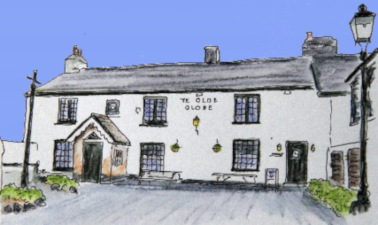

1
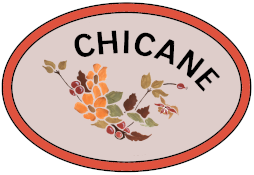
EDITORIAL
Here we are - December again! As I write this, the weather has been very wet and unpleasant for what seems like weeks, and our thoughts must go to the poor folks in the north whose homes and businesses have been flooded by rivers breaking their banks.
Christmas is not far away and now that frantic time trying to get ready - cakes, cards, puddings, presents!
Thank you to the message senders in this issue, whose generous donations will be most welcome by both the Manor Hall and the Newsletter. Thank you, as well, to Debbie for another delightful cover and for the border enhancing the messages. Debbie's continued support is very much appreciated, as is the support of all the regular contributors.
Congratulations are in order! To the Berry in Bloom team for achieving another Gold; to Alex for gaining another 'O' Level - 90 years young; to Ilfracombe reader Jeanette and her husband Norman on receiving a card from the Queen for their Diamond Wedding and Mick and Marg celebrating their Golden Wedding.
As always, we send get well wishes to all those not feeling at their best, and a warm welcome and good wishes for happiness in your new homes to all newcomers to our village. There are a lot of festive events planned in the next weeks, so make a note of them and enjoy! February will be the first issue in 2020 and items are welcome as soon as possible and at the latest by the 8th January. Thank you.
I send my best wishes to you all and your families for a happy Christmas and a happy, healthy and peaceful New Year.
Judie - Ed
2
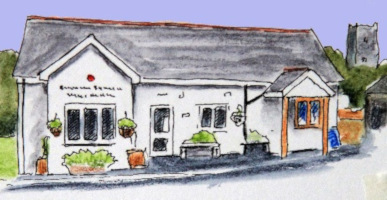
NEWS FROM THE COMMUNITY SHOP & POST OFFICE
There's so much happening at the shop this month. We have super special offers, our popular Christmas hampers' raffle, order sheets for your Christmas groceries and trees plus local produce in gift packs.
Don't miss out on our special offers you'll find in the bargain basket - you won't get them cheaper at local supermarkets - just like our sugar special that was on offer in November. Among our December promotions will be something for those relaxing moments when your only difficult decision is whether to have a brew of Yorkshire Tea or a delicious cup of Kenco coffee. Decisions, decisions!
Have you got your festive raffle tickets yet? To have a chance of winning one of our wonderful hampers you'll need to buy your tickets before Monday, 23rd December when the draw will take place and the lucky winners announced.
Shopping for Christmas food can be a really stressful experience. We can help. Just complete an order form for meat, vegetables and dairy and we'll go the extra mile so you don't have to. Orders can be taken up to midday on Saturday 21st December and collected on the 23rd and the morning of the 24th. Don't miss out! Still stuck for that present? We have put together a selection of local produce into gift packs for you to give for the special day. We can even post them for you.

And finally, here are the shop and Post Office opening times over the holiday:
- Tuesday 24th December - 08.30 to 13.00
- Wednesday 25th & Thursday 26th - Closed
- Friday 27th & Saturday 28th - Open as normal
- Sunday 29th - 09.00 to 12.00 noon
- Monday 30th - Open as normal
- Tuesday 31st - 08.30 to 13.00
- Wednesday 1st - January Closed
Karen, Annie, Jo and all the team at our Community Shop would like to wish our customers and their families a very Happy Christmas and a healthy and peaceful New Year. Come and see us soon!

3

IN MEMORIAM
EUNICE ALLEN
We are sad to announce that Eunice passed away on the 7th September. She died peacefully aged 90 after suffering with dementia for many years. Eunice and her husband Bernard, lived in the village at Bali Hai and both were active in village life.
She will be so sadly missed by her children, Val and Jeff and their spouses, her grandchildren, great grandchildren and wider family.
GORDON STANBURY
It was with sadness we learnt that Gordon, of Stapleton Farm, had passed away on the 21st September, aged 76 years.
Our thoughts are with all his family at this difficult time; with Richard and Ali, Julia and Neil, Adam and Natalie and his grandchildren, Hannah, Alison, Courtney, Katrina, Lucy, Emily and Daisy, and all his friends.

REMBERING JOAN
Joan Wood, born 5th January 1925, died 15th July 2019 - aged 94 for those like me who have difficulty with such things.
Where to start, what to leave out and how to finish looking through someone else's life of 94 years? This can only be considered as an attempt. If you take away any impressions from this retelling, they should be that Joan loved life, loved people and loved talking - her love of all three only to be surpassed by her love of laughter. Here we go!
Joan was born in Hadleigh, Essex [yes, a born and bred Essex girl] to Tom and Sarah Reynolds; the second youngest of six, following on from her twin sister Doris. The timing of the twins' birth was a little difficult, her father Tom being in hospital having lost his right leg above the knee.
Education was not Joan's cup of tea, particularly after a teacher stated that you could not see the moon in the day time. All hands in the class shot up to inform the teacher that they had observed such an object on the way to school that morning! The consequence to the unfortunate pupil who had contradicted the teacher was sufficient. Joan would never raise her hand again to ask a question at school.
But it was not all bad. Hadleigh was at that time quite a rural backwater; where cricket was played on the main London road and Joan was recognised as the best whip-and-top operator in the parish. The delights of employment were not introduced gradually, Tom - Joan's father - never allowed grass to grow under you, so organised a plum job of collar turning in a shirt factory; difficult enough even without the pressure of piece work and, of course, rejects came off the machinist's tally - not conducive to making you popular! Then came cleaning houses with no training, so laying a fire was achieved as per best boy scout practice and did not meet with universal acceptance. Glamour finally came with working at the cinema, spot lit in uniform [complete with button hat] while serving ice creams, tearing tickets in half and seeing people to their seats. Then came the Second World War.
The war effort required many to change occupation and so Joan went to working machine tools - pull this, turn this, measure here, take out, put in this bin. Working through the long nights and air raids, falling asleep at the machine was a particular hazard.
Hadleigh had the privilege of being the location of the first Salvation Army farm colonies where people had a chance to recover their lives from whatever their challenge was. They started supporting the war effort by manning canteens to provide sustenance to the many thousands of service men arriving in the area and this was Joan's next challenge. At sixteen [they never asked] they gave her a 3.5 tonne left hand drive V8 Chevrolet canteen, showed her how to change gear [double de-clutch, no synchro], where the brakes were and how they worked. Once around the square in Hadleigh, totalling just a half mile, she was signed off for driving duty, given a list of locations, an amount of food, tea, soap and other supplies, and sent on her way. Get up at 4.00 a.m., finish at 6.00 p.m. and, as can be imagined, she never stopped laughing for 4 years!
Driving became something Joan enjoyed; the war gave her a freedom that few could enjoy or experience, her ability was fostered by having to overtake long convoys of Army vehicles in the dark, fog, snow, black ice - no gritting and virtually no lights - in a left-hand drive.
After the war, at the ripe old age of 20, Joan became Manageress for Howards Dairies, running a tea room; butter cream and cake counter with three staff reporting to her, whilst enjoyable it did not provide the stimulus of war [what would!] and the loss of comradery in particular stayed with Joan all her days.
However, this pesky airman kept turning up on his motorbike and, in 1947, they were married - Joan Reynolds became Joan Wood. Upon hearing of Toby's proposal, the dairy put in their own counter proposals to Joan including a pay rise to keep her, but cupid's arrow had struck deep and she set sail for the deepest and most inland of black fens in Huntingdonshire - specifically to Roughs Farm.
As can be imagined, there was little opportunity after the war so it was not uncommon for the clans to gather. Joan arrived as others of the family de-mobbed from all over the world and so the farmhouse was populated with 14 others. Father-in-Law, George Wood, had purchased the farm in 1947 [he knew he was getting a lot of free labour, so . . .] whichhad been uninhabited; in the house, the floors had stinging nettles growing through them, there was no running water in the house, no electricity [oil lamps made a poor substitute] but it was perfectly equipped for the 19th century - including a copper and a three-seat bench toilet. The cooking facilities would not be out of place for a spit and dog. Joan's introduction to farming, along with her mother-in-law was to cook, scrub and clothes wash for 14.
Toby, Don and Joan knew all about hard work and pushed on. Now it was time to tackle living in the 20th century. The farm house was refurbished, a bungalow was built and more land purchased. The refurbishment and building achieved entirely by the brothers and Joan; once again, she taught herself a whole new set of skills, which were perfected building a grain store and dryer, along with a potato store. The final push took the farm to over 1,000 acres. During this time, as well as raising a family and working alongside, Joan was doing the book keeping -a legacy of selling cinema tickets, keeping record and billing all those contracted acres. Through hard-work, tenacity and that tiger spirit, Joan helped to achieve not just survival, but also stability and prosperity all within 15 years.
Toby had lived with his Grandmother, who farmed into her 90's, in Devon. Toby wanted to come home, his lungs gave him trouble when pollution levels were high and he discovered that North Devon had the cleanest air in England. Orchard House and another renovation beckoned. After more hard work and help from her sons, the renovation was completed, including Joan's dream garden. Large, with many different sections and opportunities for planting as many shrubs, flowers, vegetables and trees as possible - which, over the years and oddly managing to coincide with any family visiting Orchard house, had to then be cut down to let the light back in!
Alongside her joy of gardening, Joan became an accomplished artist, tried her hand at calligraphy and took up as many hobbies as she could, at last the hard work was over and they could begin to enjoy themselves in the haven they had created. They joined the University of the Third Age [founder members of North Devon Coast branch], Square dancing at Woolacombe, the Wine Circle, the WI and the Craft Group as well as being an avid competitor in the Village Show. She and Toby never lost their interest in farming and made close connections in the local farming community. Great fun was had with the Bowdens [Len and Michael], Dr. Black [the bailer twine was always appreciated], the Gubbs uncle and the Richards [Ivy]. Just a few of the people lost to us such as Tom and Vera Greenaway, Vi Kingdom, Vi Songhurst, who welcomed Joan and Toby to Berrynarbor. Joan and Toby made many friends in the area.
Toby passed away on the 3rd of April 2010. Joan had lived in Berrynarbor for 44 years.
Paul Wood
BARBARA WOOD

It was sad to learn that Barbara, who with her husband John lived on the Park, moving to Stourport on Severn some years ago, had passed away on the 13th November. Our thoughts are with John at this time of sorrow.
4
ODE OF REMEMBRANCE
Robert
Laurence Binyon
They
shall not grow old, as we that are left grow oldAge
shall not weary them, nor the years condemn.
At the
going down of the sun and in the morning
We will
remember them.
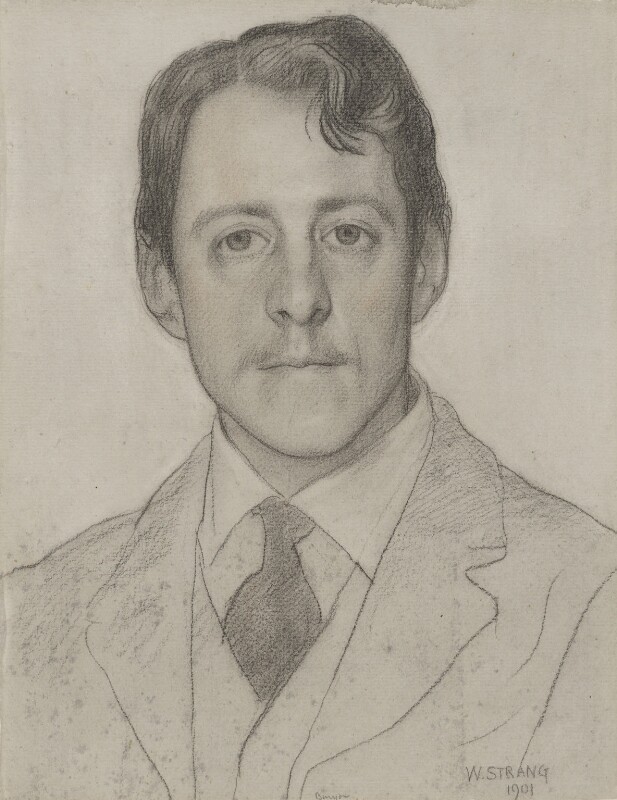
Laurence Binyon
Laurence Binyon
by William Strang
pencil, 1901
Purchased, 1944
NPG 3185
© National Portrait Gallery, London
Licenced under CC BY-NC-ND 3.0
Robert Laurence Binyon, CH [Companion of Honour], was an English poet, dramatist and art scholar. His most famous work, For the Fallen, is well known for being used in Remembrance Sunday services.
Binyon, who was born in Lancaster on the 10th August,1869, was educated at St. Paul's School and Trinity College. He died in Reading on the 10th March 1943.
Laurence Binyon composed his best known poem while sitting on the cliff-top looking out to sea from the dramatic scenery of the north Cornish coastline. A plaque marks the location at Pentire Point, north of Polzeath. However, there is also a small plaque on the East Cliff north of Portreath, further south on the same north Cornwall coast, which also claims to be the place where the poem was written.
The poem was written in mid-September 1914, a few weeks after the outbreak of the First World War. During these weeks the British Expeditionary Force had suffered casualties following its first encounter with the Imperial German Army at the Battle of Mons on the 23rd August, its rear-guard action during the retreat from Mons in late August and the Battle of Le Cateau on the 26th August, and its participation with the French Army in holding up the Imperial German Army at the First Battle of the Marne between the 5th and 9th September 1914.
Binyon said in 1939 that the four lines of the fourth stanza came to him first. These words of the fourth stanza have become especially familiar and famous, having been adopted by the Royal British Legion as an Exhortation for ceremonies of Remembrance to commemorate fallen Servicemen and Women.
Too old to enlist in the military forces himself, Laurence Binyon went to work for the Red Cross as a medical orderly in 1916. He lost several close friends and his brother-in-law in the war.
For the Fallen
With proud thanksgiving, a mother for her children,
England mourns for her dead across the sea.
Flesh of her flesh they were, spirit of her spirit,
Fallen in the cause of the free.
Solemn the drums thrill; Death august and royal
Sings sorrow up into immortal spheres,
There is music in the midst of desolation,
And a glory that shines upon our tears.
They went with songs to the battle, they were young,
Straight of limb, true of eye, steady and aglow.
They were staunch to the end against odds uncounted;
They fell with their faces to the foe.
They shall grow not old, as we that are left grow old;
Age shall not weary them, nor the years condemn,
At the going down of the sun and in the morning
We will remember them.
They mingle not with their laughing comrades again;
They sit no more at familiar tables of home;
They have no lot in our labor of the day-time;
They sleep beyond England's foam.
But where our desires are and our hopes profound,
Felt as a well-spring that is hidden from sight,
To the innermost heart of their own land they are known
As the stars are known to the night.
As the stars that shall be bright when we are dust,
Moving in marches upon the heavenly plain;
As the stars that are starry in the time of our darkness,
To the end, to the end, they remain.

5

As stated in the October edition of the Newsletter, our House for Duty Priest, Rev. Bill Cole, will be retiring in early December. The Diocese will not be replacing Rev. Bill's position, which is much regretted, and as a consequence our new Priest in Charge, Rev. Peter Churcher, has set out a revised service schedule for all three Churches - Berrynarbor, Combe Martin and Pip & Jim's - which will take effect following Rev Bill's departure.
Whilst we shall still have the valued support of Rev. George Billington and some Lay Readers from Combe Martin and Pip & Jim's, it means that we shall probably have Rev. Peter just once a month. Quite clearly this is regrettable for all three churches - but Rev. Peter cannot possibly be at all three churches at any one time! Perhaps the Diocese will re-appraise the situation we are all facing and a House for Duty Priest will be reinstated!
Our Harvest Supper was a great success and although the numbers were marginally down on last year, everyone had an enjoyable evening. As always, a great many thanks and appreciation must go to the ladies for supplying and arranging the excellent buffet for the evening, rounded off with an excellent quiz which was won by the Bellringers Table! A total of £150 was raised on this successful evening, and a cheque for this amount was sent to the Calvert Trust at Kentisbury, who cater for those with disabilities.
We must also convey our thanks to all those parishioners who gave generously to our Food Bank collection - which was taken, with Berrynarbor School's contribution, to the Salvation Army's Food Bank in Ilfracombe.
With regard to the repairs to the Church Roof and other areas, we shall be selecting a builder in the near future which will then be passed to the Diocese of Exeter, Church Buildings/Architects Dept., for ratification, and hope that the necessary work can get under way as quickly as possible.
As mentioned before in the Newsletter, we urgently need a new Treasurer to take over from Margaret Sowerby, who will be stepping down from this role. For anyone who would be willing to take on this position please contact our PCC Secretary, Alison Sharples, on 01271-882782.
Berrynarbor Choir continues under the direction of Graham Lucas, and Choir practice is held on Monday evenings commencing at 7.30pm. The Choir were invited to perform at Woolhanger Manor in their splendid octagonal Music Room where we supported North Devon Hospice on Sunday 3rd November. There is a superb pipe organ and grand piano in the music room and I had the pleasure of playing both instruments during the concert. There were craft stalls and refreshments in the music room and adjoining room and we understand that much money was raised for such a worthy cause.
Our annual Service for Loved Ones with the lighting of candles in the church was also held on Sunday 3rd November led by Rev. Peter. We were grateful to organist Ian Lovegrove for deputising for me on this occasion.
The Choir has been asked to perform once again at a special afternoon Tea on Saturday 7th December in support of Berry in Bloom.
We look forward to our Annual Carol Service in December which attracts a congregation in excess of 100, including regular parishioners, parents and visitors from afar. The service will be on Thursday, 12th December commencing at 6.30 p.m. Mulled wine and mince pies and soft drinks and sweets for the children, will be served following the service.
In addition to the above, our Christmas Eve Service will be Holy Communion with Carols, commencing at 9.30 p.m., and our Christmas Day Service - a short Family service - will commence at 11.00 a.m. We look forward to welcoming parishioners from Combe Martin and visitors for both services at this special time.
We continue to pray for those who are unwell in this Parish, especially Viv and Brian Fryer and Carol Lucas
Our service pattern for November and December is as follows:
All Church Services commence at 11.00 a.m. and are as follows:
- 1st Sunday: Village Service
- 2nd Sunday: Holy Communion
- 3rd Sunday: Songs of Praise
- 4th Sunday: Holy Communion
There will be a Joint Service on Sunday 29th December, 10.30 a.m. at Pip & Jim's, Ilfracombe.
Stuart Neale

6

WEATHER OR NOT
September and October
The word wet, or possibly very wet, spring into mind as I look back at the last two months.
The 1st of September started off with a nice dry, sunny day, 2/8th cloud cover and a top temperature of 17.2° C during the afternoon. The temperatures held up well throughout the month with the highest on the 21st at 24.0° C and the lowest on the 18th at 6.8° C. These were about the average. Looking at the rainfall, we only managed eight completely dry days in the whole of the month with several really wet ones: 9th 24.4mm - 24th 27.8mm - 25th 11.6mm - 27th 14.0mm - 28th 23.8mm. The total for the month was 159.4mm. Looking back into my records, this was the wettest September since 2000 when we had 198.00mm. There was a steady breeze most of the time with a top gust on the 27th of 35mph from the SSW, the average is 29mph. The barometer stayed high until the 19th with one exception on the 9th at 1008mbars. The rest of the month it stayed low. The highest recording on the 13th was 1035.9mbars and the lowest on 25th 996.4mbars. Total sunshine hours amounted to 121.40. The average since 2002 is 123 hours.
The 1st of October started off with 8/8ths cloud cover, light showers moving through on a steady northerly wind and a top temperature of 17.1° C which was the highest for the month. The lowest temperature was on the 28th at 3.4° C. Overall the temperatures were average.
I thought September was wet enough but in October we only had four days without some rainfall, the wettest was on the 26th when we had 38.8mm. The grand total for the month was 189.2mm. 2012 was higher at 207mm, from September the 20th to October the 22nd we had some rainfall on every day. Wind speeds were low for October, with the highest gust on 11th at 37mph from the SSW. The highest I have recorded for October is 66mph in 2002. Please remember my location as the wind speeds are considerably higher out of the Valley. The barometer was predominantly low throughout the month, on the 13th at 998.6mbars and a high of 1026.2 on the 27th. Total sunshine recorded was 61.98, this was below the average of 66.8 hours for October.November started on a wet and windy note but more on this in the next edition which reminds me it will be after Christmas, so I should like to take this opportunity to wish everyone:
A Very Happy Christmas and Healthy New Year.
Simon
7
PRESENTS!
Looking for something unusual for a Christmas gift? Why not think about one of Paul Swailes' paintings from his new collection or visit Fortythree, Fore Street, Ilfracombe for a range of gifts, the work of Paul and other local artisans.

8

NEWS FROM BERRYNARBOR PRE-SCHOOL
A First Taste of Education

New Committee
We held our AGM in October and Kirsty Kritikos remains as Chairperson as do Tina Barbeary as treasurer and Laura Maughan as secretary. They look forward to working with the rest of the committee to ensure our unique and much-loved Pre-School continues to run and provide the happy child-care that the children enjoy so much.
Our Topic
This term, the children have enjoyed exploring the environment, playing outside, sweeping and collecting leaves, going on nature walks and learning to care and look out for our native animals. Inside the children have been very busy with crafts; exploring colour, practising scissor skills and the glitter has already been sprinkled around. We have enjoyed many stories including The Gruffalo, The Ginger Bread Man, Baby Owls and Room on the Broom. The children built a lovely stand for the Baby Owls based on the story and used puppets to re-enact the story. They also produced a colourful autumn and fireworks display which brightened up our room. We have had fun cooking; making carrot cakes, pumpkin soup and bonfire biscuits, all very delicious!
It was lovely to have been invited to watch Mrs. Wellings' Reception and Year 1 Classes and Mr. Jones' Year 2 Class, do their Celebration of Learning. This year it was the story of The Three Little Pigs, with great storytelling and singing. It was good to see how well our children have settled into school.


Clothes Recycling
We had our Bags2School Collection and we are pleased to say that we raised £100.00. A big thank you goes to all those who supported us. We hope to arrange another collection in the New Year.
So, from all the Committee, the Children and Staff, we should like to wish you all
A Merry Christmas and Happy New Year!
9

10
VISIT TO ASHLEY COURT
Yet again Judie found an absolute gem of a house for us to visit just on the outskirts of Tiverton. Not open to the public, you would never know that Ashley Court was there, unless you were a yoga fanatic or happen to know Judie.

Ashley Court is a Grade II listed Regency country house, built in what was once Henry II's hunting park. The original house dates back to 1657 and was built by Tiverton wool merchant John Upcott. It was then extensively enlarged around 1805. The Court was at one time home of Thomas Cosway, uncle to the Tiverton painter Richard Cosway RA.
Ashley has an unusually well-preserved service area and has remained largely unaltered since the last major re-decoration in the Edwardian era. The current owners, Tara Fraser and Nigel Jones, are embarking on a long restoration programme, currently in its fifth year.
The house boasts original floors, fireplaces, plaster work and windows in most rooms. A glorious decorative ironwork balcony spans the front of the house; an addition by an 'outside' architect, along with symmetrical windows to ensure a gracious overall spectacle. Apparently, it was quite common at the time to then employ an 'inside' architect to ensure the interior was user friendly. It was only when Tara pointed it out, that we realised inside and out do not match. The interior craftsman had no compunction about blocking some of the windows in order to ensure rooms were functional. From the outside the house retained its symmetry.

Tara and Nigel wanted to leave the bustle of London to bring their family up in the countryside. They fell in love with Ashley Court and started the long and painstaking restoration of the place. Essentials like plumbing and electrical work have been undertaken but basically they have left the place untouched but much loved. With an exquisite eye for detail, they have ensured that many original items, such as cupboards, linen presses and other built-in features, have been retained. In the service areas and scullery. servants' bells and a huge stone sink and pump have been preserved. Walls have been touched up and quirky modern art work hung: these somehow blend perfectly with antique furniture and artifacts. The house exudes calm, hardly surprising as the new owners are both yoga teachers of some renown and run the place as a retreat. There are 9 bedrooms in all, 6 for guests.

What was evident as the tour continued was their love and respect of the place, and feeling of responsibility of bringing it back to life. They are painstakingly researching its history and have many nostalgic displays. Tara explained that when they took over the house, the last inhabitant had been a single old lady looked after by a house keeper. The rooms had been closed down one by one, and left intact until she lived in just one bedroom. They have respectfully preserved personal letters, household bills, and old photographs and artfully displayed them. Ashley Court exudes serenity and seems suspended in time.
Set in 18 acres of woodlands and gardens they have barely started on the restoration of the grounds. An extensive stable block, built in 1871, has, however, been fully restored and is used to stable their 2 horses, along with chickens, tortoises and cats. There is a magnificent three quarters of an acre walled garden and the remains of three greenhouses with heating systems and cold frames, water tanks and ancient espaliered apple and pear trees. At the head of the drive is a tiny gatekeeper's lodge, straight from a Grimm's fairytale, it also awaits the restorer's hands.
We were extraordinarily lucky with the weather as it held while we walked round the gardens only starting to rain as we entered the dining room for a delicious cream tea. It was a privilege to be allowed into the sanctum that is Ashley Court. The owners are delightful and their love of the place is evident. I seriously suggest you take up yoga so you too can have a peek into their beautiful home, you won't be disappointed!
Fenella




11

RURAL REFLECTIONS - 91
Back in the days when I owned a television, reading was just an occasional pastime. Nowadays, however, books have succeeded the square box that once dictated where all other living room furniture needed positioning. Soon after becoming an avid reader I discovered, albeit unexpectedly, that I have trends for reading certain literary genres over a period of time before moving onto another subject. At the moment it is travel journals, whether they be undertaken on foot, by train or any other mode of transport. In particular, I am enjoying accounts where an author's log is purely at the disposal of what they experience en route.
It was perhaps for this reason that I found myself writing my book about the Cairn in Ilfracombe in a mode for which I had not initially intended; that is to say a narrative, over the course of twelve months, of all the animals, insects, birds, structures, flowers, plants, trees, people and landscapes I observed. As I mentioned in my last article, I also discovered that the Cairn possessed a history and consequently had the unexpected but pleasurable challenge of intertwining this at various stages of the manuscript.
I am currently reading Robert MacFarlane's book, The Old Ways - A Journey On Foot. In it he also connects the past with the present following tracks, drove roads, sea paths, pilgrim paths, green roads, ridgeways, cartways, causeways, and other trails all of which form vast ancient networks crisscrossing the British Isles and beyond. One of these is a six-mile sea path that crosses the River Crouch connecting the Essex mainland to Foulness Island. Christened The Broomway after the bundle of twigs attached to short poles which once marked out its route, it is known to be at least 600 years old and was, until the construction of a road bridge in the early twentieth century, the only access to the island save by boat. MacFarlane warns that it is not only a tidal path but also Britain's second deadliest path, such is the speed at which the tide comes in. A sudden descent of thick coastal mist can also disorientate walkers, their footsteps misleading them out onto the treacherous mudflats.

The Broomway - Fishermans Head
©Roger Jones - via Wikimedia Commons
On the day of his walk MacFarlane relays what he sees before him: low lying mist; a pale yellow sun announcing its presence on the scene as the mist begins to peter out; a man walking his dog along the shoreline's sea wall, his outline becoming more indistinct the further MacFarlane heads out on The Broomway; and two MOD signs, one reading, 'Warning: The Broomway is Unmarked and Very Hazardous' and the other, 'Warning: Do not Approach or Touch any Object as it may Explode and Kill You.' A risk of death by drowning, suffocation or obliteration? Clearly, then, a path only to be undertaken by the more experienced walker. As MacFarlane treads his course so he reflects on all those who have passed this way before; way beyond the sea path's first known record in 1419 to a period when, not only was the River Crouch ebbed into non-existence, but a time, as he puts it, when "much of the North Sea [had] drained away [so that] what is now a sea [was] dry land . . the east coast of England [being] continuous with north west Germany, Denmark and Holland." He goes on to reflect upon an area known as Doggerland which would have been exposed around 12,000 years ago during that last Ice Age. He tells how Doggerland's later inhabitants would have easily noticed from one generation to the next, a subtle rise in the sea level as increasing temperatures caused the ice to melt; enough time, thankfully, for them to head for safer shores. Eventually just Dogger Bank, an upland area of Doggerland and an area familiar from shipping forecasts, became an isolated headland before it too was swallowed by rising sea levels around 5000BC.
MacFarlane compares our ancestor's transportation by foot, together with their belongings and livestock, as "one of the earliest substantial human responses to climate change." In other words, it is not a new phenomenon. Ironic then that I should make no reference to climate change in my book despite June 2007, one of the months of my year's observation, experiencing the highest rainfall on record and being followed by a Met Office announcement that the wettest early spring had been recorded.
As my accounts recalled, the precipitated onslaught upon the Cairn spawned a dank, soppy woodland that looked exceedingly sorry for itself; yet at no point did I explain this in phenological terms. Phenology, the study of how plant and animal life are influenced by seasonal variations in the climate, was not, along with other climatic studies and reports of the day, as much in the public domain in 2007. These days climate change is constantly in the media especially when another meteorological record is broken. This summer alone saw the hottest ever day being recorded on the 25th July when Cambridge University Botanical Garden registered 38.7 degrees centigrade [101.7 degrees Fahrenheit.] Yet it was a summer of undulating peaks and troughs for daytime temperatures, the peaks never remaining high for the required length of time to justify a heatwave.
This was in complete contrast to 2018 when soaring temperatures were sustained for long periods, something that had both negative and positive outcomes upon our plant and animal life. For example, one unexpected benefit occurred in the shallow lakes of the Wigan Flash Nature Reserve. Often plagued by algae stripping oxygen from the lakes' water, warmer than average summers ironically normally encourage algae levels to increase. However, the prolonged heatwave of 2018 spurred on large aquatic plants and in so doing crowded out the sunlight before algic blooms could appear. By increasing the lakes' oxygen levels, water fleas were able to thrive that became a valuable food source for fish such as perch and rudd which in turn provided nutrition for birds like common tern. Meanwhile winged insects flourished in the rising temperatures so providing a bumper crop of food for birds like swifts and swallows. Reptiles such as lizards and adders also benefited from insects at ground level.
But there were losers too. For example, Britain's rarer alpine plants are especially adapted to live and function in our cooler conditions; in essence, they don't 'do' heatwaves. Likewise, some of our winged insects only live at high altitude and are therefore dependent upon a cooler climate even in summer. What's more, many winged insects need a particular plant for their larvae to feed on; if their host plant was one to have suffered at the hands of last year's heatwave, then their larvae numbers will have reduced. Meanwhile, intense and prolonged moorland fires such as those seen near Manchester ravaged vegetation. This in turn destroyed seed banks, allowing the newly burnt areas to be colonised by tough, fast growing species that are easily dispersed. Rosebay Willowherb was one of the prime beneficiaries.
With a British name derived from its flowers having a passing resemblance to the wild rose and its leaves to that of the bay tree, it was also christened fireweed following the Fire of London where it appeared everywhere. Thriving as it does on disturbed land, it was a nationally rare plant until the coming of the railway created embankments and cuttings. In southeast England it is also known as bombweed, becoming a familiar site after the Blitz; London has indelible memories of drifts of the plant appearing in bombsites and craters, the plant's spiral shape becoming synonymous with the Capital's revival as it went about colonising and bringing new life to the sacred earth. It was no wonder it became London County Council's County Flower.
Being the first plant to colonise barren areas with very little competition it can today be found on wasteland, roadside verges, heathland, moorland, beside railways and well-drained rivers and in woodland clearings. Perhaps regarded by some as a garden weed, it is important to remember that the re-establishment of vegetation is crucial in the recovery time of disturbed land; Rosebay Willowherb's early arrival therefore plays a pivotal role. It is for this reason that it is purposefully planted where oil spillages have occurred; once established, new vegetation will grow underneath. Each plant can produce up to 80,000 hairy, fluffy seeds that are especially adapted for colonising, their tiny cottony 'parachutes' dispersing across long distances upon the slightest of breezes.
Watching these seeds in flight at the end of autumn always makes me think ahead to Christmas - and in particular the cards with well wishes that will travel many miles to re-establish contact, albeit maybe just yearly, between family, friends and acquaintances. It is easy to regard writing Christmas cards as a laborious prerequisite of the festival period. But try to remember the happiness it will give the recipient - just like the joy you experience with each card you receive.
Merry Christmas!
Steve McCarthy
12
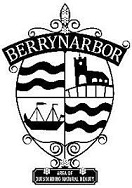
FROM THE PARISH COUNCIL
Berrynarbor Parish Council
Chairman - Adam Stanbury [882252]
Gemma Bacon [883341]
gemmabacon@berrynarborparishcouncil.org.uk
Martin Johns
martinjohns@berrynarborparishcouncil.org.uk
Jody Latham
jodylatham@berrynarborparishcouncil.org.uk
Vice-Chairman - Sian Barten [882222]
sianbarten@berrynarborparishcouncil.org.uk
Adrian Coppin [882647]
adriancoppin@berrynarborparishcouncil.org.uk
Lesley Lowe
lesleylowe@berrynarborparishcouncil.org.uk
Parish Clerk - Victoria Woodhouse - clerk@berrynarborparishcouncil.org.uk
County Councillor - Andrea Davis [883865]
District Councillor - Joe Tucker Frederick.tucker@northdevon.gov.uk [328890]
Snow Warden - Clive Richards [883406]
Parish Councillor Debbie Thomas has stepped down from her position, resulting in a vacancy on the Council. If you are interested in joining the Parish Council, please contact Kate Graddock via email or 07703 050496. The Council thank Debbie for giving her time over the past few months.
Airband:
Members are keen to hear positive and negative comments from the recent installation from Airband. There are concerns regarding their conduct and councillors will be discussing at the next meeting whether to lodge concerns with the company.
Berrydown/Lynton Cross Junction:
Members were presented with a proposed scheme for Berrydown and Lynton Cross by County Councillor Andrea Davis. Members were positive in that there will be improvements but there were items raised that could help improve the schemes, such as the possibility of solar powered street lights and reducing the speed limit to 20mph at Berrydown and widening the existing roadway and keeping the road to Two Pots open at Lynton Cross.
Section 106 Money:
The Parish Council has just over £20,000 available from 106 money from the Fold Yard Planning Application and will be allocated funds potentially to 3 projects: The Manor Hall Play Park, Manor Hall refurbishment and improvements to the Recreation Field.
Manor Hall Play Park:
A new toddler swing seat has been fitted and the rotten bench removed thanks to Councillor Coppin.
Car Park and Toilets:
Members agreed to continue discussions with North Devon Council on taking over the toilets and Castle Hill Car Park.
Ash Tree in Recreation Field:
This has been confirmed as having stage 2 Ash Dieback, and will, therefore, be felled in the very near future.
New Litterbin at Pitt Hill:
The Council agreed to purchase a new cast iron litterbin to replace the broken bin on Pitt Hill. This will be installed in January 2020
Council Grants:
The Parish Council would like to make residents aware that there are Council grants available from North Devon Council to help vulnerable residents remain in their homes.
North Devon residents who need to make home improvements, repairs or adaptions will soon be able to apply for enhanced grants to help them get the work done, thanks to a funding injection of £2 million to North Devon Council.
The Council's new policy has been made possible thanks to an allocation of money from the Better Care Fund [BCF], a government initiative that brings existing resources from the NHS and local authorities into a single budget. The BCF seeks to join up health and care services so that people can manage their own health and wellbeing and live independently in their communities for as long as possible. Grants are means tested and will be subject to eligibility criteria. Information about the grants, when they become available, will be posted on North Devon Council's website www.northdevon.gov.uk/housing and social media pages.
Kate Graddock - Acting Parish
Clerk [07703 050496]
clerk@berrynarborparishcouncil.org.uk
13


14


15
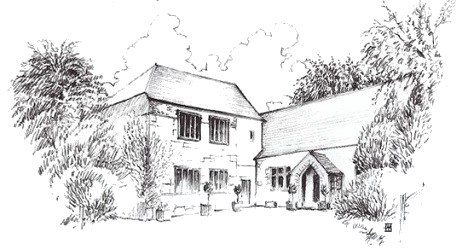
Manor Hall Trust
CIO 11619090
Well, our first venture into women's fashion was a great success with ticket sales being over subscribed for the Ladies Night which was held on the 6th of November. Over 90 jolly ladies [helped by a glass or two of Prosecco!] squeezed into the hall to enjoy a very entertaining show of clothes, jewellery and handbags, along with treatments from Beauty at the Beach from Combe Martin and skin care from Tropical. The whole evening raised just under £650 for the hall so thank you to all who attended.
A big thank you must also go to Bernadette and her team from Clathers of Ilfracombe who worked so hard and gave us a very generous £250 donation along with some lovely raffle prizes. Well done to all our brilliant models, some of whom were familiar village faces and who really got into the spirit of things. There is no doubt they will be receiving phone calls from Dolce and Gabbana before too long!
Lastly, we must once again thank all our hard-working Hall Trustees and including their partners, for all their help and especially our chef de cuisine, Caroline, for her delicious canapes. We very much hope to be putting on a Spring/Summer Ladies Night, so look out for the date in the New Year and buy your tickets early!
Sadly, we are bidding a fond farewell to Alison our Bookings Clerk who has been part of the Hall management for many years. Alison has been such a hardworking, dedicated and well-liked member of the team, going down to the hall all hours of the day and night, rain or shine to let people in or to sort out any problems. She will be sorely missed. We send her and Trevor our grateful thanks and best wishes.
Lastly on Saturday 14th December we have our Christmas Coffee Morning between 10.00 a.m. and 12 noon. Please join us for a coffee or mulled wine and mince pie.
A very Happy Christmas and New Year to you all
Julia - Chairman & Bookings
16
MARWOOD HILL GARDENS - FESTIVE TEAS
 We are serving a range of Festive Foods in the Tea Room from
We are serving a range of Festive Foods in the Tea Room from
10.00 a.m. to 4.00 p.m. on the following weekends:
Saturday & Sunday, 30th November and 1st December
Saturday & Sunday, 7th and 8th December
Saturday & Sunday, 14th and 15th December
Booking is advisable
Ring [01271] 342528 or e-mail: info@marwoodhillgarden.co.uk
17

BERRY IN BLOOM
In this year's R.H.S Britain in Bloom campaign, Berry in Bloom were awarded GOLD. As this is the highest award, we are all thrilled! What a great team the village has - many thanks to everyone involved.
The judging marks are divided between Horticulture 40%, Environment 30%, and Community 30%. This year we have been working especially on the Environment aspect. With permission from the Parish Council, we are leaving some places and a section of the dog walking field with longer grass and hopefully the wild flowers will return to these areas. We have spread some hay from a local wild flower meadow hoping that the seed will fall and generate, but we shall also be adding some wild flower plugs. This will take at least 3 years to get going so keep an eye open for our progress. If you spot a scruffy area with a blue wooden heart it will be an area we are trying to re-wild so please bear with us.
The team is standing down until the spring except for two fund- raising events. The first on 7th December in the Manor hall starting at 2.30 p.m. with the doors opening at 2.00 p.m. This will be an afternoon with a Berry in Bloom Christmas Tea accompanied by our Village Choir singing Christmas songs and a light hearted table quiz. Judie will be running a raffle towards funds for the newsletter. Do come along and support us, and on a cold afternoon enjoy a lovely tea and some singing. Tickets £5.00 available from the Shop. The second will be our annual Quiz Night with Quizmaster Phil and this will be on Friday, 7th February in the Manor Hall.
Once again, we'll be singing Christmas Carols in the square on Christmas Eve, commencing at 6.30 p.m. with Phil Bridle on the organ and the singing led by Tony Summers.
Make sure you come promptly as a little bird has told me the singing will commence with a solo from a visiting opera singer! Mulled wine and mince pies will be served, and Colin and myself, at Bessemer Thatch, will be gratefully accepting bottles of red wine towards the refreshments. In case of a downpour, we'll move to The Globe.
Wendy Applegate
18

Mincemeat Squares with Cranberry Marzipan Streusel Topping
I am addicted to marzipan so when I saw this Christmas recipe I thought I'd give it a try.
For the Topping
- 150g plain flour
- 150g demerara sugar
- a pinch of fresh grated nutmeg
- 50g soft butter in pieces
- 150g ready-made golden marzipan
- 150g pecans
- 150g fresh cranberries
For the cake
- 200g ground pecans
- 200g soft butter, plus a little extra for greasing
- 150g golden caster sugar
- 4 large free-range eggs lightly beaten
- 50g plain flour
- 4 tbsp mincemeat
Butter and line a 20cm x 30cm baking tin that is at least 4cm deep.
Preheat the oven to 180 Deg C, fan 160 Deg C, gas 4.
For the topping, mix the flour, sugar and nutmeg in a bowl, then rub in the butter and mix again. It will be a crumbly mix. You can also do this in a food processor.
For the cake, whizz the pecans in a food processor or mixer until a fine powder, then in a bowl whisk together with all the other ingredients except the mincemeat, until combined. Spread the cake mix into the prepared tin. Blob the mincemeat on top of the cake and swirl it over the mix.
Finish the topping by dicing the marzipan and roughly chopping the pecans. Add these to the topping crumble mix along with the cranberries. Stir and scatter over the cake and mincemeat mix.
Bake in the oven for 40-45 minutes or until risen and lightly golden. Cool in the tin before slicing into 24 squares.
Happy Christmas baking!
Wendy Applegate
19

CHILDHOOD LITERATURE
"Forth
to the wood did merry-men go
To
gather in the mistletoe."
from An Old Time Christmas, Sir Walter Scott [1771-1832]
"There is no time of the year at which we honour more old customs than at Christmas time. The whole season is full of them, and their beginnings go back down the centuries into the mists of time.
"We keep many of these old customs without knowing their meaning - but it adds much more to their interest if we know how they began, where and why. Why is plum-pudding called that when there are no plums? Why do we always hang up holly and mistletoe/ Why do we give presents, and have a Christmas tree? Who was Santa Claus?"
So writes Enid Blyton in the Foreword of one of her probably lesser known books - The Christmas Book - first published in 1944.

Noddy and Big Ears - After Harmsen van der Beek
Illustration by: Judie Weedon
Blyton's writings for children were prolific with over 600 million copies sold. Perhaps the Adventure Series - Jack, Lucy, Dinah, Philip and Kiki Philip's pet parrot, The Famous Five - Julian, Dick, George, Anne and Timmy the dog, The Secret Seven, the St. Clair's and Mallory Towers series, Mary Mouse and Sunny Stories are amongst the most popular, but Noddy must also be mentioned with Noddy Goes to Town, the first of 24 written between 1949 and 1963.
From 1907 to 1915 she attended St. Christopher's School in Beckenham, where she excelled in physical activities and writing, but not so in the academic subjects. After leaving, she moved to Woodbridge in Suffolk and in 1916 enrolled on a National Froebel Union Teacher Training course which she completed in December 1918 gaining a teaching certificate with distinctions in Zoology and Principles of Education, 1st Class in Botany, Geography, Practice & History of Education and Child Hygiene and 2nd Class in Literature and Elementary Mathematics.
In August 1924 she married Major Hugh Alexander Pollock DSO [1888-1971] who was involved with the publishing firm George Newnes, which became her regular publisher. In July 1931 and living in Bourne End, her daughter Gillian was born and following a miscarriage, her second daughter Imogen was born in October 1935.
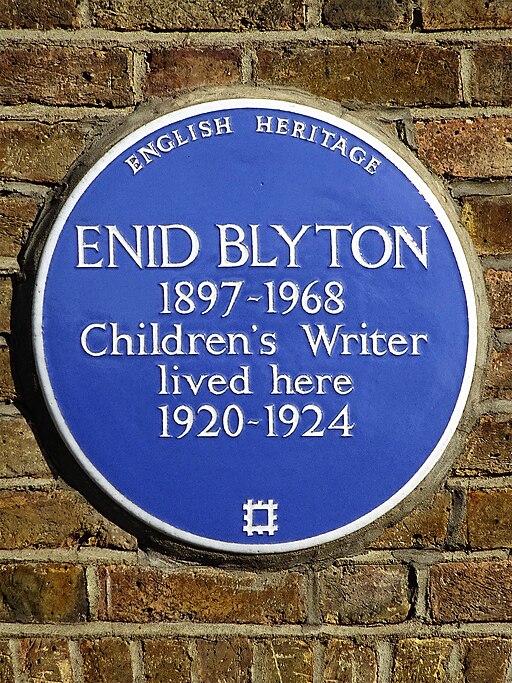
Blue plaque erected in 1997
by English Heritage
207 Hook Road, Chessington KT9 1EA
Spudgun67, CC BY-SA 4.0
via Wikimedia Commons
In 1938 the family moved to Green Hedges in Beaconsfield. By this time Pollock had withdrawn from public life and become an alcoholic, later having an affair with an aspiring writer 19 years his junior, Ida Crowe. With her marriage under strain, Enid herself began a series of affairs and in 1941 met Kenneth Fraser Darrell Waters, a London Surgeon. Fearing that her adultery would ruin her public image, she filed for divorce against Pollock and providing that he would admit infidelity, he would have access to their two girls. But, following the divorce she reneged and he was forbidden to contact them. Having married Crowe in 1943, he resumed his heavy drinking and was forced to petition for bankruptcy in 1950.
Enid and Darrell Waters married in October 1943 and she publicly embraced her new role as a happily married doctor's wife. After discovering that she was pregnant in the spring of 1943, she miscarried five months later following a fall from a ladder. This would have been Darrell's first child and the son for which both of them longed.
In 1957, Blyton's health began to deteriorate and by 1960 she was displaying signs of dementia. Her agent George Greenfield recalled that it was 'unthinkable for the most famous and successful of children's authors with her enormous energy and computer-like memory' to be losing her mind to what we now know as Alzheimer's in her mid-sixties. Unfortunately, this was not helped by the fact that her husband's health was bad - he was suffering from severe arthritis, deafness and increasingly becoming bad tempered. He died in September 1967.
Following his death, Enid's health declined rapidly and she moved into a nursing home three months before her death on the 28th November 1968. She was cremated at Golders Green Crematorium where her ashes remain.
Due to the controversial criticism of her writing which has been said to be elitist, sexist, racist and xenophobic and in particular her Noddy stories, her books have in some cases been banned from libraries and schools, but they have continued to be best-sellers.
Judie Weedon
20
LOCAL WALK - 177
Holdstone: "Holy Mountain"?! - Strange Encounters
At 1143 feet, it is the highest coastal hill in the South West. That's quite an impressive claim to fame but to some it is a holy mountain.
When we ascended Holdstone Down in mid-September, our mission was threefold. We were hoping to see wheatears before they embarked on their autumn migration.


Secondly, I anticipated catching a glimpse of the dull but scarce grayling butterfly which is only on the wing for a few weeks in late summer until September. It is the largest member of the brown family of butterflies but as it always settled with fawn and grey marbled wings closed, it is very inconspicuous.
And thirdly, we wished to find the heather still in full colour. Happily, that day the moor presented a tapestry of magenta bell heather and mauve ling with golden yellow patches on the Western gorse.

An encampment had established itself in the normally quiet car park and I threaded my way between kettles and cooking utensils in order to reach the start of the path.
Half way up the hill I observed a pair of wheatears moving a little ahead of me, pausing very upright at intervals, flitting their tails. They flew off when a runner sped past but I caught up with them on one of the other paths radiating out from the summit.

Beside the cairn at the top I discovered a group of people praying. So, now a word about the Aetherius Society and Holdstone's reputation as a sacred site.
About sixty years ago George King, the founder of the Aetherius Society, claimed to have met Jesus there, having seen a bright blue light over the Bristol Channel which heralded the arrival of a being from Venus - Jesus, who instructed him to pray for world peace and enlightenment.
Followers of George King meet at Holdstone to chant mantras and access spiritual and psychic energy from the site, which they store in a strange contraption called a Spiritual Energy Battery, to be released in the event of disaster.
The very first time we climbed Holdstone Down, long before we had heard about these strange and bizarre beliefs, we met a man running down from the summit in a state of excitement. "Is it true?! he asked. "Is it really true that you can recharge your batteries up there?"
We reassured him this was not to be taken literally, that it was simply metaphorical. Last autumn as we descended, we noticed an elderly couple had emerged from their camper van and were staring intently at a small patch of heather clad ground.
They gave a friendly greeting as we passed and continued minutely to examine the clump of heather. Curiosity got the better of me. Had they discovered some rare insect or wild flower, I wondered. I retraced my steps to enquire. It turned out they were engaged in the popular pastime of geocaching.
Illustrations by: Paul Swailes
Sue H
21

22

The Song of the Holly Fairy
O, I am green in Winter-time,
When other trees are brown;
Of all the trees [so saith the rhyme]
The holly bears the crown.
December days are drawing near
When I shall come to town,
And carol-hoys go singing clear
Of all the trees [O hush and hear!]
The holly bears the crown!
For who so well-beloved and merry
As the scarlet Holly Berry?
Cicely Mary Barker
Reproduced by permission of Frederick Warne & Co.
23
MOVERS AND SHAKERS - NO. 84
JOHN JEWEL
[24 May 1522 - 23 September 1571]
Bishop of Salisbury Cathedral 1560-1571, A leading Protestant Reformer
Standing at our Post Office counter were two visitors clutching a slim booklet and asking Karen to stamp it. Karen looked bemused, and not surprisingly! When Alan Rowlands was consulted; he'd never seen a stamp either. The booklet was entitled Passport to North Devon, and underneath Alphabet of Parishes and was published in 1995! [If you want to see more, put Alphabet of Parishes into Google and then The Sheepwash Chronicle. It tells you about this fascinating scheme devised by Danny Hughes, an employee of Devon County Council and an environmental charity. A famous local potter, called Harry Juniper, designed the different wall plaques for each of the 26 villages represented.


How did I find this out? Well, the visitors gave me the name of the publisher, who went out of business in 2002, and told me that the reason for coming to Berrynarbor was to find the 'J' reference to Bishop Jewel which they said they had discovered in the porch of our church. I went straight to the church and on walking through the lychgate, my husband said "There it is!" and sure enough, high on the left side as you walk through the gate you will see it. Perhaps you already have, perhaps you even remember it being fixed there, but I've not spoken to anyone since then who has seen it.
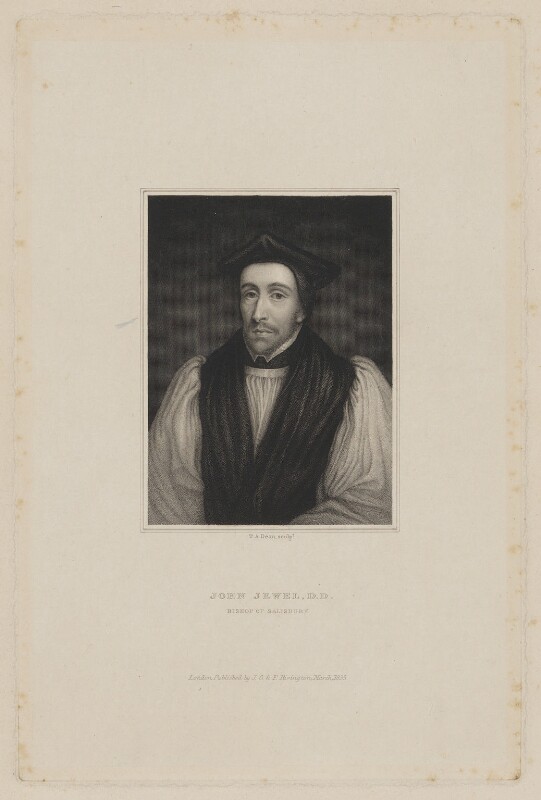
John Jewel
by Thomas Anthony Dean, published by John Rivington,
published by George Rivington,
published by Francis Rivington, after George Vertue
stipple engraving, published March 1835 (1715)
Acquired, 1964
NPG D36520
© National Portrait Gallery, London
Licenced under CC BY-NC-ND 3.0
After a number of 'phone calls, I latched on to the Beaford Centre, now in South Molton, who found a reference copy of the book and kindly let me take photographs. Unless you are very keen, don't try to get a copy. Initially it cost £1.99. One went recently for over £10.
It has some interesting facts though. Combe Martin is represented as 'K' for kiln and Ilfracombe as 'Q' for quay. Presumably their plaques are somewhere in their respective places.
But that brings me to Bishop Jewel. He was born at Bowden Farm, here in the Sterridge Valley on May 24th 1522, the younger son of John Jewel and his wife Alice Bellamye. He was educated by his uncle, a rector, and by other private tutors until being accepted at Oxford's Merton College at the tender age of 13. By 1540 he graduated with a BA and five years later with an MA. He worked so hard throughout his studies that he fell ill with rheumatism and became ill for life as a result.
John Jewel lived in tumultuous religious times. Henry Vlll had declared the English Reformation - breaking away from the catholic faith. His son, Edward Vl had succeeded his father at the age of nine in 1547. Six years later he became mortally ill and Mary, his older sister and only child of Henry Vlll and his first wife Catherine of Aragon, succeeded him in July 1553. She was determined to reverse the Protestant reforms. By the time of Queen Mary's accession, John Jewel was Public Orator of the university and had to write an address of loyalty to her. Eventually he was forced to flee for his life when his strong Protestant views became known. Otherwise he might have become one of over 280 dissenters burnt at the stake during the Queen's five-year reign. He fled to Frankfurt and later publicly repented for signing the address of loyalty.
After Queen Elizabeth became queen in 1558, Jewel returned to England and in 1560 was appointed Bishop of Salisbury. In this role, he restored the cathedral spire and improved the standard of preaching, introducing a preaching rota for the clergy. Many of his fellow bishops were still reluctant to change to Protestantism. Elizabeth soon saw in Jewel a scholar who could establish the type of church she wanted.
After just two years in office, he published a book, the Apologia pro Ecclesia Anglicana [Apology for the Church of England] which was the first defence of the Church of England against Roman Catholic claims. His argument was that the English Church Reformers were not setting up a new church, but going back to the primitive one. He also defended the Church of England against Puritans who rejected the Book of Common Prayer and wanted to replace bishops with another type of Church government. Interestingly, he wrote it in Latin because it wasn't meant just for England but to be read by scholars across Europe. Lady Ann Bacon, mother of Francis Bacon, translated it into English in 1564.
Bishop Jewel was forty years old when he wrote the Apology, which became his most important work. Queen Elizabeth was so impressed that she demanded that copies of it be chained beside Bibles on the lecterns all over the country. The old volume is still found in some churches, still chained to its post.
John Jewel continued with his other commitments: building the cathedral library and opening a cathedral school for underprivileged youngsters amongst other things, working incessantly and limiting himself to four hours' sleep daily between midnight and four in the morning. He never married and after preaching a sermon in Laycock, Wiltshire, he collapsed and was taken to the manor house in nearby Monkton Fairleigh, where he died on 21st September 1571, at the age of 49. He is buried in Salisbury Cathedral.
And so, the small village of Berrynarbor produced a 16th century learned English reformer who 'did much to start to define what was unique and different about the English church'. A number of books have been written about his life and even though he died so young, Bishop Jewel made a lasting impression on the accepted religion of England.
[Grateful thanks to Keith and Margaret for giving me the idea and notes and to the Beaford Centre for photographs]
PP of DC
24
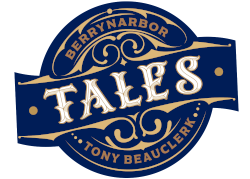
HEROES OF THE TIME

I go back to the 'forties when my school days were at Ilfracombe Grammar School.

There was a report that one of the pupils, who lived at Woolacombe, heard, late at night, a dog barking. Upon getting out of bed and getting dressed, he realised that the dog was stranded on a rock and the only way to save it was to swim out and get it. This, he bravely did and was commended by the Headmaster, Mr. Tatton, the following day.
Our next hero was - if I remember right - a Peter Lattimer who lived at Combe Martin. A boy had fallen down the Camel's Eye and Peter volunteered to go down and rescue him. A rope was lowered and Peter went down, bringing the boy, who I believe had minor injuries, to safety.
The next heroes were the fishermen of Combe Martin. They took their boat out into the Bristol Channel regardless of the danger of mines, which could break loose from their moorings, and German submarines. Despite this they would bring back a catch of rock salmon, herrings and pollock. These they sold straight from their boat for 1d or 2d each. I recently paid £8.50 for one very large cooked plaice! Still, it is some 70 years later!
Wishing everyone a Merry Christmas and a Happy New Year.
Tony [and Betty] Beauclerk - Stowmarket

Illustrations by: Paul Swailes
25

FROM THE PRIMARY SCHOOL
Three dates for your diary:
- Wednesday, 4th December: Senior Dudes' Christmas Meal at the Manor Hall. Have you signed up to enjoy this special evening being waited on by the older pupils?
- Friday, 6th December: The P.T.A. are holding a Festive Bingo ion the Manor Hall. Doors open at 6.30, eyes down at 7.00 p.m.
- Wednesday, 18th December: Walking Nativity. Come and join us as we tell the story of Christmas whilst walking through the village, from 6.00 p.m.
26
NATIONAL POETRY DAY - ON QUOTING SHAKESPEARE
The Prince of Wales marked the 25th Anniversary of National Poetry Day on the 3rd October, by recording a reading of Bernard Levin's Quoting Shakespeare.
"I should like to read what I've always thought was something rather special. The great thing about it, I think, is it reminds us all just how many words and phrases we use in the English language and in general conversation which actually were written by Shakespeare."
.jpg)
King Charles III - July 2023
White House Public domain
via Wikimedia Commons
If you cannot understand my argument, and declare "It's Greek to me'', you are quoting Shakespeare;
If you claim to be more sinned against than sinning, you are quoting Shakespeare; If you recall your salad days, you are quoting Shakespeare; If you act more in sorrow than in anger; if your wish is farther to the thought; if your lost property has vanished into thin air, you are quoting Shakespeare; If you have ever refused to budge an inch or suffered from green-eyed jealousy, if you have played fast and loose, if you have been tongue-tied, a tower of strength, hoodwinked or in a pickle, if you have knitted your brows, made a virtue of necessity, insisted on fair play, slept not one wink, stood on ceremony, danced attendance (on your lord and master), laughed yourself into stitches, had short shrift, cold comfort or too much of a good thing, if you have seen better days or lived in a fool's paradise -why, be that as it may, the more fool you , for it is a foregone conclusion that you are (as good luck would have it) quoting Shakespeare; If you think it is early days and clear out bag and baggage, if you think it is high time and that that is the long and short of it, if you believe that the game is up and that truth will out even if it involves your own flesh and blood, if you lie low till the crack of doom because you suspect foul play, if you have your teeth set on edge (at one fell swoop) without rhyme or reason, then - to give the devil his due - if the truth were known (for surely you have a tongue in your head) you are quoting Shakespeare; Even if you bid me good riddance and send me packing, if you wish I was dead as a door-nail, if you think I am an eyesore, a laughing stock, the devil incarnate, a stony-hearted villain, bloody-minded or a blinking idiot, then - by Jove! O Lord! Tut tut! For goodness' sake! What the dickens! But me no buts! - it is all one to me, for you are quoting Shakespeare.Bernard Levin
27

BERRYNARBOR WINE CIRCLE
A numbers' game!
The 3rd Wednesday of October, saw the 1st evening of Berrynarbor Wine Circle's 2019-20 season. We began with our AGM, usually less than 10 minutes; however, on this occasion, we had discussions about our forthcoming Christmas event, so deliberations took 20 minutes and then we returned to 6 other matters, our tastings.
For some time, we have expected to see Chris Bullimore of the Wine Beer Supermarket, in Cherbourg. Unfortunately, he had a much-needed hospital appointment on the Thursday morning, the day after our 1st meeting, so, understandably, he needed to cancel for the 4th time! He seems to come, or not as the case maybe, with a lot of Murphy's Law!
At the 11th hour, Tony, our Chairman, stood in, and presented Booze on a Budget. We sampled a Cremante de Loire, a white fizz. Cremante is described as being streets ahead of Prosecco, but the latter has benefitted, somewhat, from a boost by Italian marketing. It's driving their growth, according to the National Institute of Statistics. Taste was O.K, but many thought it was too fizzy. We followed this with a 2018 white, Cotes du Rhone, unusual, as Cotes du Rhones are usually red. Our last white was a Sauvignon Blanc. People talk about the nose, some dismiss this, but one sniff from the glass and most around us said it smelled strong, which matched its taste. This was a punchy, typical Marlborough, New Zealand S.B. It was produced in a single vineyard in the Awatere Valley. Geoff, my husband, is a white wine drinker, often drinks S.B., but didn't like this one. Others near us weren't that keen either.
Our next 3 wines, all red, were Portuguese, French and Italian. Our 1st was the Azinhaga de Ouro, a 2017 - wow! This was a Douro Reserva; it was a beautiful brown-red and SOooo smooth. Many loved it and, apparently, it would keep for up to 5 years. Probably wouldn't in our house! Geoff cannot drink much red, but said he'd be prepared to have a migraine for this one! The Rasteau, 2016, from the Rhone Valley followed; it wasn't as smooth as the Douro, but it was 15%, whereas the Douro was 14%. Our Rasteau was described as being a good vintage. Barolo, sounds Italian and is. Ours was a 2014, 14%, that had a distinctive flavour; it too had a good brown-red colour. This was good, but most of us thought that the Douro was better. Tony had purchased all of these from Lidl's in Ilfracombe. As an organisation, Lidl's are seeking to stock better wines and as their slogan is 'When it's gone, it's gone', if you see something, you really do need to buy it there and then. Our dearest of the night was £11.99, the Barolo, but >the cheapest of the evening was £5.99 and the wow factor, yes, the Douro! We have, bought a number already!
Judith Adam - Promotional Co-ordinator & Secretary
Next Meeting: Wednesday, 15th January - Call My Wine Bluff
28
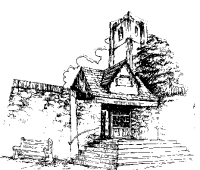
FROM REV. BILL
Dear Friends
The run up to Christmas is very hectic; it's amazing just how much hustle and bustle there is before The Big Day. This year is particularly hectic for me and my wife as we say goodbye to North Devon and move to our home in Cumbria at the beginning of December, as you can imagine we will have a lot to think about.
Almost everyone gets caught up in the busyness and material stuff of a commercialised Christmas: shopping till we drop, giving children as many presents as the house can hold, and buying enough food to keep a whole street alive for a week! It seems ironic then that the very first Christmas Day welcomed the birth of the Prince of Peace, and it is on Christmas Day, when many of us are so tired all we want is to be left in peace and sleep it off!
The lead up to Christmas doesn't need to be so hectic, though no-one needs to dread it, because ultimately if we choose, Christmas can really be a time of joy and peace. Christmas will always be Christmas. After all we are celebrating the most significant event in history; if you can think of a more significant one, let us know. The birth of Jesus brought not only a new way of life to the world, one that continues to stand the test of time, but also brought God into the world that he made.
And on that first Christmas Day in the tiny village of Bethlehem, the world was amazed at the sight of a baby wrapped in cloths and lying in a manger, and just for a moment the world and heaven were joined as one as: "Suddenly a great company of the heavenly host appeared...praising God and saying, 'Glory to God in the highest, and on earth peace to those on whom his favour rests.'" (Luke 2:13,14)
Have a very happy and peaceful Christmas, and may God's favour rest on you.
Bill Cole
We thank Bill for his contributions to the Newsletter and wish him and his wife a joyous and peaceful Christmas and health and happiness in their home in Cumbria.
Merry Christmas for St. Peter's
You are very welcome to all of our services, many of which have mince pies and mulled wine too! Look out for posters or pop into the church for more information.
If you're not sure of the reason why we celebrate Christmas, here is a good tip: There are 24 days in December before Christmas, and 24 Chapters in Luke's version of the Jesus story in the Bible. Why not read just one chapter a day? Once you get to Christmas, you'll know what you're celebrating!
May you know the reason for the season and the joy He can bring.
Rev. Peter Churcher
29

30

Great Torrington

High Bickington

Parracombe
THE NORTH DEVON PRAYER
Our landscape
Wrought here in North Devon
Hallowed be thy Ilfracombe
Thy King's Nympton come
Thy Lee and Woolacombe
This earth be it Instow, Stoke or Meddon
Give us Croyde Bay and Muddiford
And forgive us our Barnstaple
As we honour Brayford, Sheepwash and Great Torrington
Lead us through all Tarka request stations
But deliver us from Yeo Mill
for North Devon is High Bickington
The Parracombe, Week and Warleigh
for ever and ever
Barum
Beaford Arts
Contributed by: Nora and Alan

Instow

Brayford

Ilfracombe

Kings Nympton
Illustrations by: Paul Swailes
31
AT-A-GLANCE DIARY
| DECEMBER | |
| 3rd | Mobile Library in Village from 11.40 a.m. |
|---|---|
| 4th | Wine Circle: Christmas Meal at The Globe |
| 5th | Pre-School Christmas Performance, Manor Hall, 2.00 p.m. |
| 7th | Arts & Crafts Market, Sawmills, 10.00 a.m. to 3.00 p.m. Berry in Bloom Christmas Tea, Manor Hall, from 2.00 p.m. |
| 8th | Pip & Jim's Church, Ilfracombe: Light Up a Life Service, 6.30 pm |
| 10th | Parish Council Meeting, Manor Hall, 7.00 p.m. |
| 12th | Election Day. St. Peter's Church: Annual Carol Service, 6.3 p.m |
| 14th | Manor Hall Christmas Coffee Morning, 10.00 a.m. - 12.00 noon |
| 19th | Ilfracombe Academy: End of Autumn Term |
| 20th | Primary School: End of Autumn Term |
| 24th | Carols in the Square, 6.30 p.m. St. Peter's Church: Christmas Eve Service, 9.30 p.m. |
| 25th | CHRISTMAS DAY St. Peter's Church: Family Service, 11.00 am |
| 29th | Pip & Jim's Church, Ilfracombe: Join Service, 10.30 a.m. |
| 31st | New Year's Eve |
| JANUARY 2020 | |
| 1st | New Year's Day |
| 6th | Ilfracombe Academy & Primary School: Start of Spring Term |
| 14th | Mobile Library in Village from 11.40 a.m. Parish Council Meeting, Manor Hall, 7.00 p.m. |
| 15th | Wine Circle, Manor Hall, 8.00 p.m. Call My Wine Bluff |
| 25th | Soup & Pud Evening, Manor Hall, 6.30 for 7.00 p.m. |
| FEBRUARY | |
| 7th | Berry in Bloom Quiz Night, Manor Hall |
| Manor Hall Diary | |
| Mondays | Upholstery, 9.00 to 1.00 p.m.Craft Group, 1.45 p.m. Badminton, 7.30 p.m. |
|---|---|
| Tuesdays | N.D. Spinners [2nd & 4th] 1st and 3rd: Craft Art Group, 9.30 a.m. |
| Wednesdays | Pilates Body Workout, 9.00 a.m. Primary School p.m. |
| Thursdays | Watercolour Painting 10.00 a.m. [10 week
terms] Pilates, 7.00 to 8.00 p.m. |
| Fridays | Primary School p.m. |
| Penn Curzon Room | Pre-School: Daily - Term time only Morning Session: 8.30/9.00 - 12.00 p.m. Afternoon Session: 12.00 to 3.00/3.30/4.00 p.m. All Day: 8.30/9.00 a.m. to 3.00/3.30/4.00 p.m. |
| Mobile Library | |
| Village Shop: 11.40-12.10 p.m. Sterridge Valley: 12.25-12.55 p.m. | |
School, Pre-School and Toddler Group - Term Time only
32
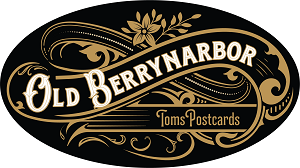
OLD BERRYNARBOR - VIEW NO. 182
For Christmas I have chosen a local view of Ilfracombe overprinted with 'Xmas Greetings' and an Art Nouveau embossed card.
The first card, Ilfracombe 'Evening', shows a view from Lantern Hill, of Capstone Hill and Ilfracombe and is numbered 21107 in the Picture Post Card series.

The second card has a Brighton postmark of December 22nd 1903 and was published by Raphael Tuck & Sons in their Christmas Series 1739, chromographed in Berlin.

The two New Year postcards are both upright views. The first shows a pretty young lady with a lucky white rabbit. It, too, was published by Raphael Tuck & Sons but in their Continental Series 2572 with an Ilfracombe postmark 1st January 1905.


The second card, 'Anne 1755' shows a young lady in a full ball gown, holding a fan, having apparently been carried in a two-man sedan chair. Note the spelling of 'Happie Newe Yeare' Yet again, this has been published by Raphael Tuck in their Christmas Series 1901..
I should like to wish everyone a Happy and Prosperous New Year 2020.
Tom
Bartlett
Tower
Cottage, November 2019
e-mail:
tomandinge40@gmail.com
33